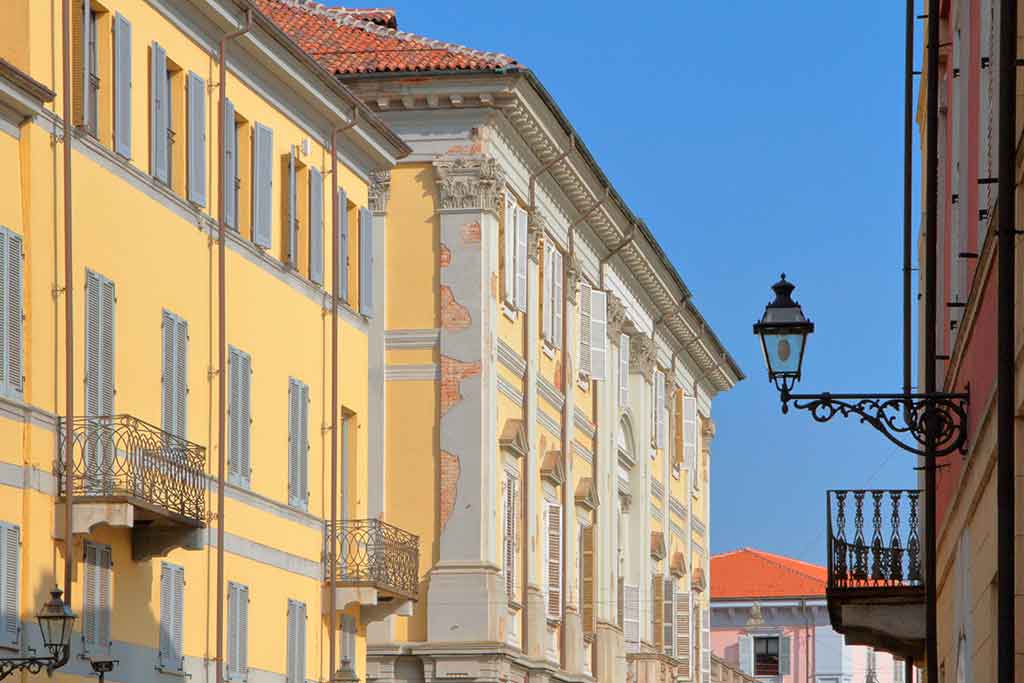Welcome
to Vercelli Italy. If you’are planning to visit Vercelli for your next trip and you are
looking for the best places to visit, here you’ll find tips and suggestions of most
popular point of interest and activities not to be missed in Vercelli and surrounding.
Travelers will appreciate this italian town with
his rich historical and artistic heritage, local culture and environment. Discover the monuments, buildings, natural
treasures and all the details that characterize Vercelli and its territory. Share and suggest a place you've
visited.

Elegant buildings in the center of Vercelli
Not only are big cities like Turin and Milan rich in works of art. Often real treasures are hidden even in the provinces. Vercelli is one of these places where art is intertwined with natureFrom the cultural point of view Vercelli is placed immediately after Turin & lt; /em> and Asti. This small town contains real treasures, almost everything concentrated in the center. A must therefore walk through the streets of the historic center, very narrow and winding on which medieval towers and ancient Renaissance and Baroque palaces overlook.
Very beautiful is Piazza Cavour, of medieval origins, surrounded by porticoed houses, on which the Torre dell'Angelo stands out. Famous is the Burgundy museum, the largest and most important art gallery in the Piedmont region.
The flagship is the church of Sant'Andrea with its colorful facade and two bell towers. The basilica was built in the '300 but the lonely bell tower is from the '500. Inside you should see the wooden choir and the crucifix. The Duomo, on the other hand, is a construction carried out in various eras, from the Middle Ages until the '800. In the Treasure Museum of the Duomo you can admire beautiful jewellery objects and the 'Vercelli book', a collection of writings by unknown hand in ancient English, of origin unknown.
The most interesting church is the Church of San Cristoforo that will amaze you with the magnificent interiors frescoed by Gaudenzio Ferrari. Vaults, walls and ceilings are full of color and masterfully designed scenes. Passing on Piazza San Marco you can see a building called the Arca, it was the church of San Marco. Here today you can visit the exhibition Peggy Guggenheim. In recent years, the Ark has become a sort of branch of the famous museum in Venice with beautiful art exhibitions.
Vercelli, with its houses and churches, also has a great historical and artistic interest and is remembered as an important stage and refreshment place along the Via Francigena, one of the busiest routes in Europe of the Middle Ages. It was not a real road, but a set of alternative routes and paths, which led from France to Rome with some landmarks, which were hardly ignored from travelers, among whom the city stood out. School and university headquarters from 330 AD to the present day is remembered by Thomas Jefferson, the third president of the United States, in the letters of his trip to Italy in search of renowned rice species.
Probably founded by the Celts, redesigned in the structure by the Romans, it was the seat of a free municipality in the Middle Ages, a member of the Lombard League opposite Frederick I Barbarossa, and domination of the Lombardy Visconti as later of the Savoy.
written by Zita Ocran - Last update: 04/10/2021
This guide has been translated automatically through a third party service. Visititaly offers these automatic translations to help site visitors, however the automatic translations may contain inaccuracies, errors or inaccuracies. You can contact us to report inaccuracies or errors and we will check the translation.